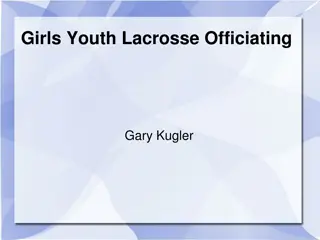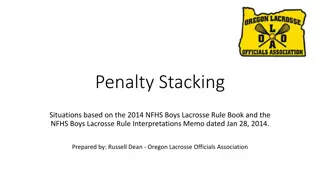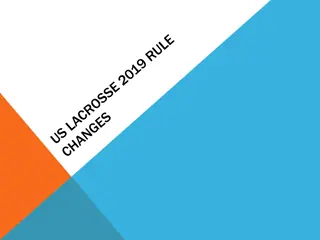Girls Lacrosse Statistics and Strategies: A Comprehensive Overview
Explore the essential statistics required in girls' lacrosse, including draw controls, draws possessions, turnovers, and more. Understand why tracking stats is crucial for player development, evaluation, coaching strategies, and league awards. Dive into the details of draw controls, draw attempts, draw possessions, and how to accurately record and analyze these stats for individual players and teams.
Uploaded on Sep 14, 2024 | 2 Views
Download Presentation

Please find below an Image/Link to download the presentation.
The content on the website is provided AS IS for your information and personal use only. It may not be sold, licensed, or shared on other websites without obtaining consent from the author.If you encounter any issues during the download, it is possible that the publisher has removed the file from their server.
You are allowed to download the files provided on this website for personal or commercial use, subject to the condition that they are used lawfully. All files are the property of their respective owners.
The content on the website is provided AS IS for your information and personal use only. It may not be sold, licensed, or shared on other websites without obtaining consent from the author.
E N D
Presentation Transcript
GIRLS LACROSSE STATISTICS GIRLS LACROSSE STATISTICS
Overview Why do we keep stats? League Awards Player development Player evaluation Coaching strategy
What stats are we required to keep? Required Statistics for league awards Draw Control Draw Attempt Draw Possession Ground Ball Caused Turnover Turnover Assists Shots Goals Saves Games played Yellow/Red cards
Draw Controls (DC) A Draw Control (DC) is awarded to the player who controls the ball after the draw, or creates an opportunity for her team to control the ball; i.e.-a controlled flick of the ball to an open teammate. If there is a foul called before control is established( i.e.- illegal draw, body ball, etc), then the player who is awarded the ball is credited with the draw control. A player who gets a Draw control does not also get a ground ball. Draw controls and ground balls are mutually exclusive
Draw Controls (DC) Contd Sometimes, a draw will take place, but the official halts play and restarts with a redraw. In this case, DC should only be decided at the outcome of the redraw. You do not need to note redraws.
Draw Possession / Draw Attempt)
Draw Attempt Each time a draw is taken, you will record the player who is taking the draw. In most games, the number of draws will equal the total score of the game plus 2. Example: the score of the game is 10-8. One draw was taken before each goal (10+8=18). Plus one draw to start the game and one draw to start the 2nd half. (18+2+20). Exceptions: overtime games or when a draw control is not secured by the end of the half or the end of the game.
Draw Possession (DP) The girl playing center of the team that records the Draw Control is awarded a Draw Possession. Draw attempts divided by draw possessions give you the draw percentage. This is both a team statistic and an individual statistic.
Draw Percentage Example Sally took the draw 10 times and we got possession 5 of those times. 5/10 = 50% Therefore, Sally s draw percentage = 50% Suzie took the draw 10 times and we got possession 3 of those times. 3/10 = 30% Therefore, Suzie s draw percentage = 30% As a team what is our draw percentage? 8/20 = 40%
Ground Balls (GB) A Ground Ball is recorded when a ball changes possession during live play or when the ball hits the ground (due to a check, drop, errant pass, or shot) and retrieval of the loose ball is directly contested (within a stick s length) by the opposing team. Exception: After a shot, neither team is in possession of the ball. Therefore, the player securing the ball in the field of play during live play is given a ground ball.
Ground Balls (GB) If a player drops the ball, and it is not contested, she should not be awarded a ground ball when she recovers it, but if she drops a ball that is contested, she should be awarded a ground ball upon recovery of the ball. Forced or unforced errors are not taken into consideration when awarding a ground ball. A ground ball shall not be awarded if the ball (on a pass or shot) is sent out-of-bounds since the ball is dead before possession is gained. A ground ball shall not be awarded if a player is given the ball because of a foul or infraction since obtaining the ball was not during live play. Should a player be fouled in the act of attempting to possess the ball (while her stick is in contact with the ball) possession is to be assumed, and a ground ball should be recorded.
Caused Turnover (CT) This is a defensive statistic. This is a positive statistic. A caused turnover is only when a change of possession occurs as a result of one of the following: Stick check The player who preforms a legal stick check to dislodge the ball is awarded a caused turnover if there is a change of possession. Interception The player who intercepts their opponents pass is awarded a caused turnover (player should also be awarded a GB) Blocked pass The player who blocks a pass is awarded a caused turnover if there is a change of possession Drawn charge The player who draws a charge is awarded a caused turnover. (hint: the referee will award the ball to the player who drew the charge.
Turnover (TO) This statistic is used to record an instance in which a player loses control of the ball to the other team or performs an action to cause her team to lose possession of the ball. For example, bad passes, fouls, not catching the ball, dropping the ball, etc. This is an offensive statistic. This is a negative statistic.
Assists An assist is a play made by a player to her teammate who then scores a goal without having to evade excessive defensive pressure (other than the goal keeper). It is not necessary for the shooter to possess the ball for a specific length of time, nor must the shooter limit the number of steps taken after she receives the ball for a shot. Only 1 assist per goal may be awarded, but not every goal will have an assist.
Shots A shot is any attempt by a player to score a goal. A shot can have several outcomes. It may be a goal or a save, it may go wide of the goal, or it may be blocked by a defender s stick. If a foul is called on the shooter (i.e.- dangerous propelling, etc.) then no shot is recorded. The shooter should then be given a turnover (TO) Shots should NEVER be recorded as turnovers.
Goals A goal occurs when the entire ball passes completely over the goal line and should only be recorded if the signal has been given by the official. Sometimes the ball will go in the cage and the goal will be disallowed because of a violation or a foul. It is important to watch for the signal! If a girl scores against her own team, it should be recorded for the opponent as an own goal (OG), and a turnover should be given to the player who put the ball in the goal.
Saves A save is recorded each time the goalie stops a ball from going into her goal that, if she didn t stop, would have resulted in a goal for the opponent. If a goalie stops a shot (either by catching it or deflecting it away from the mouth of the goal with her crosse or body), it is a save. There cannot be more saves recorded than shots taken by the opposing team!
Saves A shot that goes wide is not a save (even if the goalie stops it in her stick). A shot that hits the pipe is NOT a save. When determining if a goalie should be credited with a save, it is important to consider what would have happened if the goalie was not there. A blocked shot is considered a shot wide.
Yellow/Red Cards Yellow/Red cards are a sub-set of major fouls. It is essential that all yellow/red cards be recorded. Yellow/Red cards need to be recorded for the league in order to verify game play eligibility and post-season award eligibility. Anytime a yellow or red card is given in a game, the player name, number, game time, and card type (y or r) should be recorded in the scorebook and/or the stat sheet. Statisticians should also record why the card was given.
Overview Stats words of wisdom Use a pencil Use commas to differentiate numbers Have spotters When you are statting, girls have numbers, not names. The table area is neutral, please don t cheer, yell at officials, etc. Stats need to be uploaded to the utahlax.org website within 48 hours the completion of the game.























